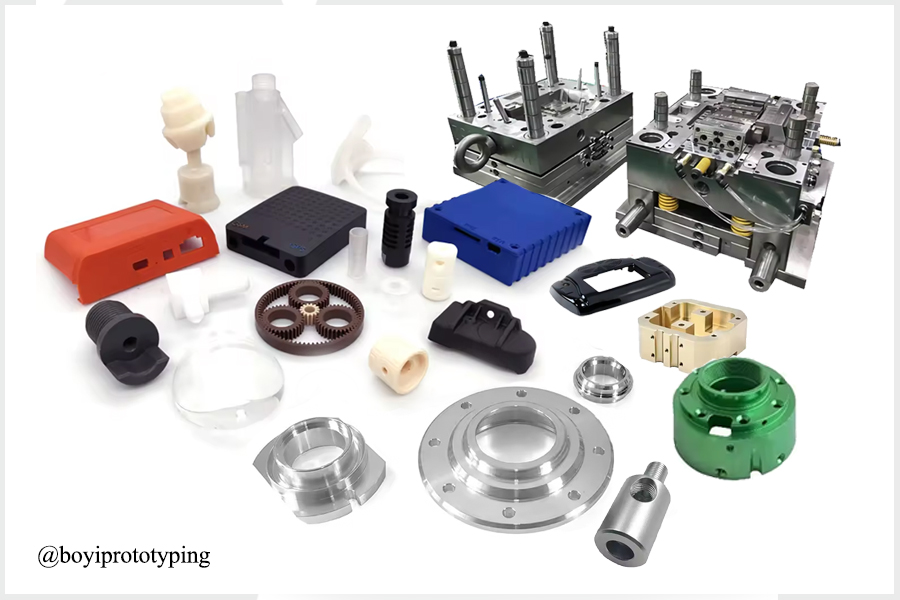
BOYI specializes in CNC machining for large parts, offering precision and efficiency. Our advanced workshop is equipped with 3-axis, 4-axis, and 5-axis CNC machines capable of producing prototypes and parts within 3 days. We excel in manufacturing parts with strict tolerances, including those over 4000mm in length. BOYI is the trusted choice for clients requiring large, complex, and precision-machined components. Learn more about our large parts CNC machining services.
Here is a detailed guide to help you understand large parts CNC machining.
What is Large CNC Machining?
At its core, large CNC machining is the process of using computer-controlled machines to remove material from a solid block (or “blank”) of metal, plastic, or other materials to create a desired shape or part. These machines, often occupying entire factory floors, are equipped with advanced cutting tools that move along multiple axes (typically three to five) to achieve the desired geometry with extreme accuracy. The scale of large CNC machining allows for the production of parts with dimensions often exceeding several meters in length, width, or height.
How Does It Work?
The magic starts with a CAD (Computer-Aided Design) file. This digital blueprint contains all the details of the part you want to make, from its dimensions to its intricate features. This file is then converted into a series of instructions that the CNC machine can understand, known as G-code.
Once the G-code is loaded, the CNC machine takes over. It’s like a robot chef following a recipe to a T. The machine’s cutting tools, whether they’re spinning drills, milling cutters, or laser beams, move precisely along the pre-programmed paths, shaving off material layer by layer until the final part emerges.

What Are the Key Considerations for Large Part Machining?
When machining large parts, consider the following:
How Many Setups Are Needed?
Large parts often need to be machined in several setups. Each setup processes a different segment of the part. Ensuring accurate alignment between setups is crucial for maintaining feature consistency.
What About Size and Weight?
The size and weight of the part can impact machining feasibility. If the part exceeds the machine’s size or weight limits, it must be machined in sections. Additionally, height constraints can be a limiting factor.
Are There Enough Tools?
Specialized machines for large parts are less common, and many shops focus on smaller lot sizes. Large machining tools may require manual finishing, which can be slow and labor-intensive.
How Does Heat Affect Accuracy?
Achieving precision across multiple setups demands meticulous attention to detail. Large parts generate significant heat, which must be accounted for in machining calculations to prevent accuracy issues.
Common Parts Produced by Large-Scale CNC Machining
Large-scale CNC machining is capable of producing a wide variety of parts across different industries. Here are some examples of parts that can be manufactured using this technology:
- Aircraft fuselages
- Engine housings
- Landing gear components
- Engine blocks
- Transmission housings
- Chassis components
- Excavator arms
- Bulldozer blades
- Gearboxes
- Propeller shafts
- Hull sections
- Structural supports
- Turbine blades
- Generator housings
- Industrial machinery frames
- Custom prototypes
These examples demonstrate the versatility and capability of large-scale CNC machining in producing parts that require precision, strength, and durability.

What Are the Design-Phase Considerations for Large Part Machining?
When designing large parts for machining, keep these considerations in mind:
- Segmenting the Part: Breaking large parts into smaller segments can simplify machining and assembly. This approach reduces complications and can lead to innovative designs.
- Choosing the Right Machine: Select the appropriate machine and model for your part. For instance, a mill might be better than a lathe for certain operations. CAD software can help determine the best setup.
- Preparation: Ensure your setup accommodates the part’s size and weight. This might involve removing machine enclosures or using additional supports. Check for potential collisions and adjust the setup as needed.
- Handling Geometries: Optimize part orientation to fit within the machine’s work envelope. Rectangular parts can be aligned using stops, while round parts should be spun for better access.
- Tool Selection: Utilize tools like right-angle heads and fly cutters to extend reach and improve machining efficiency.
By addressing these design-phase considerations, you can streamline the machining process and achieve high precision for large-scale parts.
Kickstart CNC Machining for Your Next Project
Ready to bring precision and efficiency to your next project? With our advanced CNC machining services, you can turn complex designs into reality with unmatched accuracy and speed. Whether you need prototypes or full-scale production, our state-of-the-art machines and expert team ensure every part is crafted to perfection. Start your project today and experience the difference precision CNC machining can make!

Let’s Start A New Project Today
Our engineers will contact you within 2 hours.
FAQ
CNC machines can work with a wide range of materials, including metals like aluminum, steel, brass, and titanium, as well as plastics, wood, and composites.
CNC machining offers high precision, with tolerances as tight as ±0.001 inches, ensuring exceptional accuracy for even the most complex designs.
CNC machined parts can be finished with a variety of surface treatments, including anodizing, powder coating, polishing, and painting, to meet specific aesthetic or functional requirements.

This article was written by engineers from the BOYI team. Fuquan Chen is a professional engineer and technical expert with 20 years of experience in rapid prototyping, mold manufacturing, and plastic injection molding.







